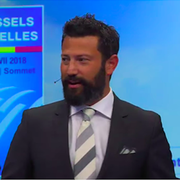
Str/Allen/AP
How a Rock Concert Turned Nelson Mandela into a Cold Warrior
In standing for justice, Nelson Mandela helped end 20th-century totalitarianism. His 1988 birthday concert was a shot fired.
Three years after Live Aid became legend and set a new standard for social justice mega-benefit concerts, the world’s top musical acts put on another big concert, known simply as the Concert for Nelson Mandela. Neither show was a first. Big concerts designed to raise money, awareness and public consciousness (often at great risk) for a political or socio-economic issue have existed for hundreds of years. In the 1700s, still under British rule, musicians sang in Boston churches to raise funds and awareness for Revolutionary War fighters. In the 1800s, they sang for women’s suffrage. In 1949, black entertainer Paul Robeson’s civil rights concert in Peekskill, N.Y., ended with race riots. In 1968, performers sang at Carnegie Hall to protest working conditions for California grape pickers. Woodstock was Woodstock. And in 1971, George Harrison threw the Concert for Bangladesh at Madison Square Garden.
In 1985, Live Aid took the mega-concert to a new, global level. In the modern age of MTV and cable, satellite television, the dual show in London and Philadelphia ultimately was about hunger in Africa – which honestly seems dishearteningly quaint today. Farm Aid was more about, well, helping American family farmers survive modernity, more than hunger. And even Mandela’s concert, technically, was a birthday bash.
But really, it was something more.
In 1988, things were already changing between the United States, the Soviet Union and Eastern Bloc countries behind the Iron Curtain. The officially titled “Nelson Mandela 70th Birthday Tribute” was much more than another Live Aid. It was a Western-designed, Western-underwritten, Western-produced middle finger to oppressors. Tony Hollingsworth, its executive producer, wrote in Friday’s The Telegraph how he led a carefully planned public relations event designed to change the prevailing messaging frame at the time, which was that Mandela, still imprisoned, was a “black leader” – even a “black terrorist leader” – in the news media. Mandela still was in jail, but Hollingsworth sought to change his public image and that of the larger anti-apartheid movement. His aim was for white, affluent First World audiences to see something positive they could latch onto. Instead of clips of dark-skinned bottle-throwing street protestors fighting in far off, Third World South Africa, Hollingsworth presented a new image that was accessible to mall-shopping teens and their parents thousands of miles from Soweto. Hollingsworth replaced street fighters with Sting, Tracy Chapman and Stevie Wonder. Instead of bottles and bullets, beloved mega pop stars and songs of peace were thrust right into the living rooms and earphones of the First World. And the Second World.
But what does a concert where Meat Loaf introduces Salt-N-Pepa singing “Push It” shortly before the Fat Boys do “The Twist” have to do with the Cold War and global security? Consider what happened behind the scenes. For weeks, concert organizers and anti-apartheid organizations received bomb threats demanding they cancel the show. Conservative politicians who hated apartheid but controversially opposed economic sanctions against South Africa complained that the show would raise money for an armed rebellion. (It didn’t.)
The show went on, and it was huge. The Mandela concert filled London’s Wembley Stadium and lasted for 12 hours. The broadcast reached 600 million people. But not in South Africa, where it was banned. And not the United States where Fox television, by all accounts, chickened out. For the U.S., the concert was repackaged as “Freedomfest,” dropping the title reference to Mandela out of fear of losing sponsors like Coca-Cola. Americans only saw a watered-down, six-hour version that cut out the big political speeches and visual backdrops, outraging many performers.
But the show also was seen in the Soviet Union and China. The Soviets already long had claimed the anti-apartheid banner as their own before the West, in the same way they claimed communism to be more about equality than the American way of life, given the racial civil rights turmoil of the century. In the same year as the concert, with Mandela still locked up, the USSR issued a commemorative stamp for Mandela’s 70th birthday with his picture on it. It soon would prove that the “Evil Empire” could not claim the world’s newest, greatest symbol of freedom and maintain its stronghold on its own people much longer.
After the concert, Mandela’s lawyers asked Hollingsowrth to begin planning a second event in London for after his release from prison. Anti-apartheid leaders credited the concert for putting enormous pressure on South Africa to make Mandela’s release all the more inevitable. And at the second Wembley event, Mandela gave a global speech to a sold out stadium of 74,000 people.
Did the concert change the world? Well, it’s a tricky subject lacking adequate study. But here’s what is known – by the end of the decade, more people in the world wanted to sing, dance, dress like free Westerners -- and wanted their MTV. In short, they wanted to be like us more than we wanted to be like them. And the chains that held them back were bound to break as inevitably as Mandiba’s had. After all, Tracy Chapman was talkin’ ‘bout a revolution, right in their living rooms.
Nelson Mandela’s release in South Africa may have been a tertiary Cold War victory far from Moscow. But it shook the global political landscape and threatened ideologies as adequately as any ballistic missile.
It was a shot fired in the Cold War.
